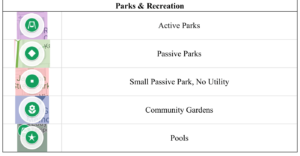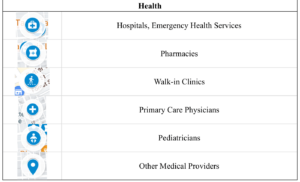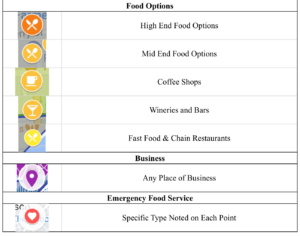Quantitative Analysis Methodology
Amenities mapping is an effective way to visualize the number of services and places of interest that are in a neighborhood. One of our main objectives was to create an amenities map of Easton in order to get a good understanding of the current state of the city. The four neighborhoods; College Hill, Downtown, West Ward, and South Side all face their own challenges and we aimed to identify each of the neighborhood’s greatest strengths and weaknesses. The map was created through Google Maps. Our map includes distinct layers that were used to isolate specific locations and amenities on the map. There are two location layers, one for each neighborhood and one for each census block. A census block is the smallest geographical unit used by the United States Census Bureau. Amenity layers are divided into subcategories of services. Examples of subcategories include restaurant, grocery, and health. The amenities were labeled using the key that can be accessed through this link. With the City of Easton Amenity Map, we were able to then create a foundation for calculating walk times.






In order to get walk times, we closely followed the X Minute City’s criteria of being within a 15-minute walk of an amenity category. We recorded the time it took to walk from the population center of each census block in Easton to the nearest amenity in each individual subcategory. However, for businesses, restaurants, and cultural amenities, we calculated the number of every location within 15 minutes due to a surplus of these amenities in Easton. The time to each amenity was recorded through the use of Google Maps, which allowed us to take into consideration obstacles such as elevation, stoplights, and more.
Some obstacles and walk time restraints were not taken into consideration, such as the safety and condition of sidewalks. These restraints were complex to identify and incorporate into our walk times due to the lack of data and input available.
We took the information obtained from asset mapping of each neighborhood and used it to get the data into a standard score for each amenity so that our findings could be more easily understood. By taking the travel times of each amenity in the census blocks and weighting them by population, we were able to obtain a weighted average time of walking to each amenity within a neighborhood as well as the entire city.
Weighted Walk Time Average = SUM(P*t)/P
P = population
t = walk time to amenity
Qualitative Analysis Methodology
We employed a qualitative data collection and coding analysis to further assess walkability and accessibility in Easton. Data collection was used to obtain information through interviews with Easton community leaders. The data gathered from these interviews was subsequently coded into themes and patterns using an inductive approach. The purpose of the qualitative analysis was to gather information from community members in order to generate more comprehensive themes surrounding walkability and accessibility in Easton. Additionally, it allowed us to incorporate direct words from Easton residents, allowing our project to move outside of the classroom and truly collaborate with the community.
While this analysis employed a formal data collection and coding method, it was not intended to be an all-encompassing study of how Easton community members understand walkability in their neighborhoods. As opposed to random sampling, our analysis heavily relied on purposeful sampling because of the limited resources of this study. In other words, we chose to speak with community leaders who live and work across Easton’s four neighborhoods who can provide important insights about their communities, representing the interests of locals. To ensure a fair analysis of the qualitative data, the coded information obtained from the interviews was paired with the quantitative data (ie. walkability scores) in order to draw nuanced conclusions that were representative of the state of walkability and accessibility in Easton.
